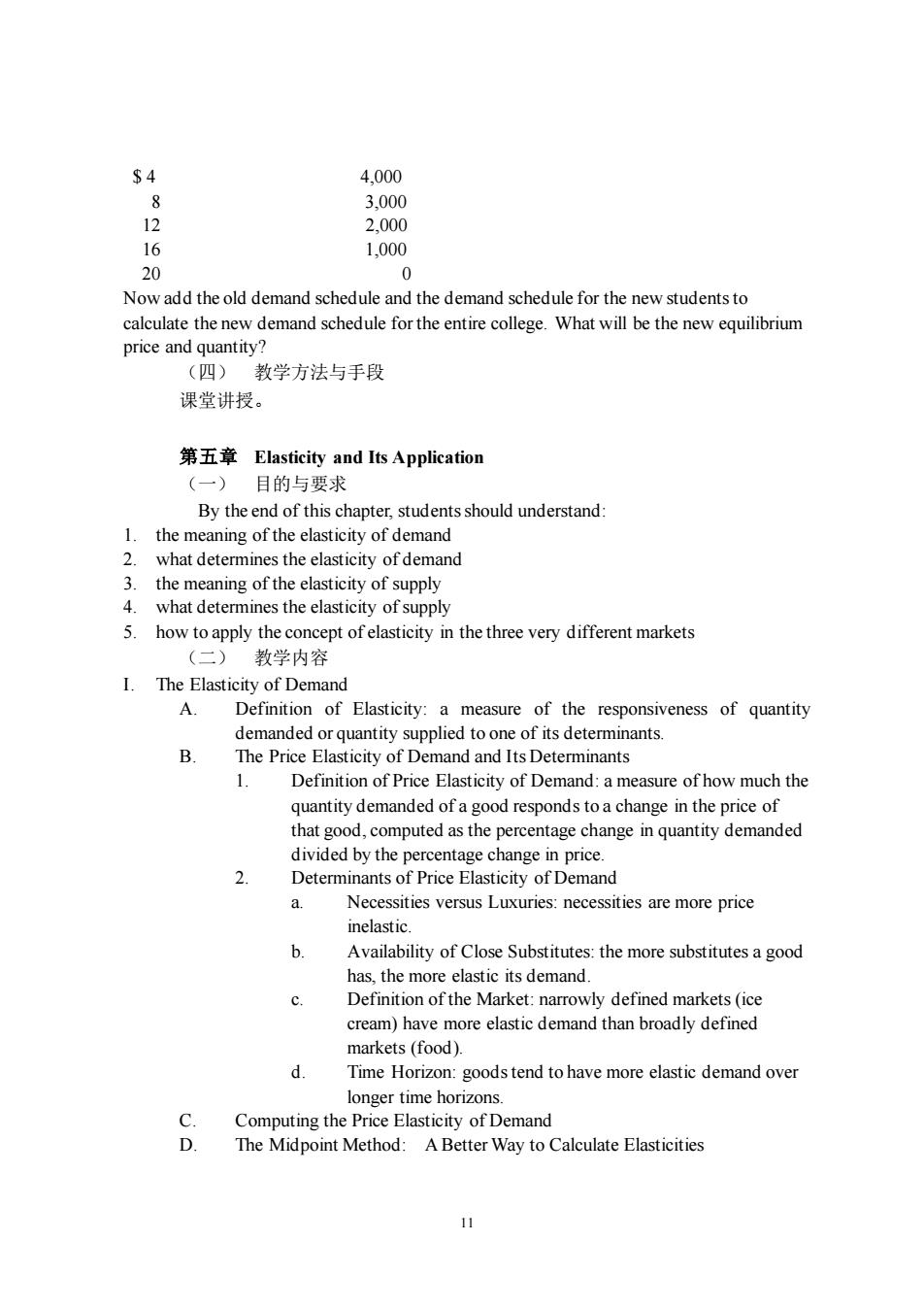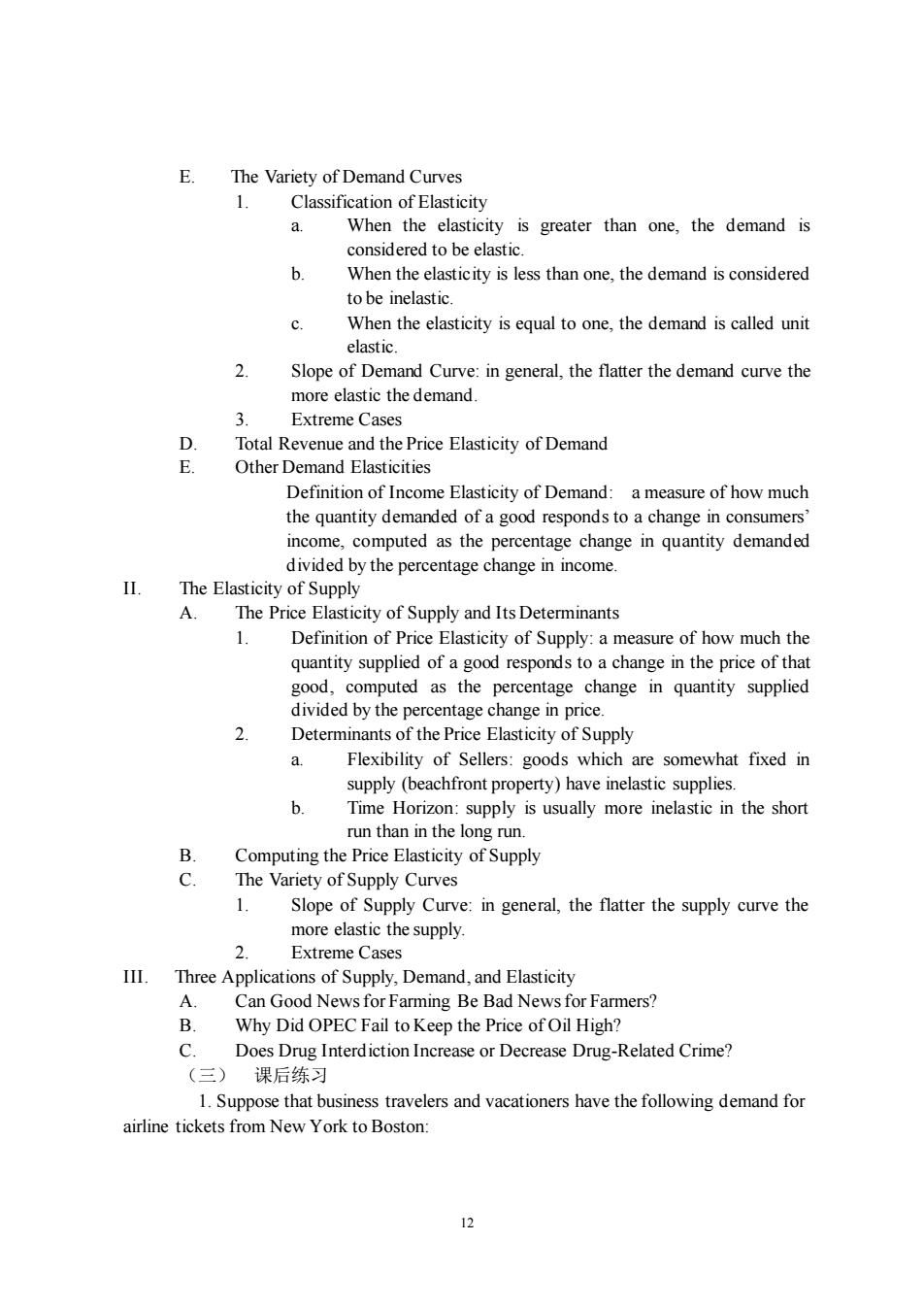
$4 4.000 8 3,000 12 2.000 16 1,000 20 Now add the old demand schedule and the demand schedule for the new students to calculate the new demand schedule for the entire college.What will be the new equilibrium price and quantity? (四) 教学方法与手段 课堂讲授。 第五章Elasticity and Its Application (一) 目的与要求 By the end of this chapter,students should understand 1.the meaning of the elasticity of demand 2 what deten nines the elasticity of demand of supply 4 5.how to apply the concept ofelasticity in the three very different markets (一 教学内容 I.The Elasticity of Demand A. Definition of Elasticity:a measure of the responsiveness of quantity demanded or quantity supplied to one of its determinants. B The Price Elasticity of Demand and Its Determinants Definition of Price Elasticity of Demand:a measure ofhow much the quantity demanded of a good responds toa change in the price of that good,computed as the percentage change in quantity demanded divided by the percentage change in price. Determinants of Price Elasticity of Demand Necessities versus Luxuries:necessities are more price inelastic Availability of Close Substitutes:the more substitutes a good has,the more elastic its demand. C. Definition of the Market:narrowly defined markets(ice cream)have more elastic demand than broadly defined markets(food). d Time Horizon:goods tend to have more elastic demand over longer time horizons. C Computing the Price Elasticity of Demand D The Midpoint Method:A Better Way to Calculate Elasticities 11
11 $ 4 4,000 8 3,000 12 2,000 16 1,000 20 0 Now add the old demand schedule and the demand schedule for the new students to calculate the new demand schedule for the entire college. What will be the new equilibrium price and quantity? (四) 教学方法与手段 课堂讲授。 第五章 Elasticity and Its Application (一) 目的与要求 By the end of this chapter, students should understand: 1. the meaning of the elasticity of demand 2. what determines the elasticity of demand 3. the meaning of the elasticity of supply 4. what determines the elasticity of supply 5. how to apply the concept of elasticity in the three very different markets (二) 教学内容 I. The Elasticity of Demand A. Definition of Elasticity: a measure of the responsiveness of quantity demanded or quantity supplied to one of its determinants. B. The Price Elasticity of Demand and Its Determinants 1. Definition of Price Elasticity of Demand: a measure of how much the quantity demanded of a good responds to a change in the price of that good, computed as the percentage change in quantity demanded divided by the percentage change in price. 2. Determinants of Price Elasticity of Demand a. Necessities versus Luxuries: necessities are more price inelastic. b. Availability of Close Substitutes: the more substitutes a good has, the more elastic its demand. c. Definition of the Market: narrowly defined markets (ice cream) have more elastic demand than broadly defined markets (food). d. Time Horizon: goods tend to have more elastic demand over longer time horizons. C. Computing the Price Elasticity of Demand D. The Midpoint Method: A Better Way to Calculate Elasticities

E The Variety of Demand Curves 1. Classification of elasticity When the elasticity is greater than one,the demand is nsidered to be elastic b. to be inelastic. When the elasticity is equal to one,the demand is called unit elastic more elastic the demand Extreme Cases D Total Revenue and the Price Elasticity of Demand Other Demand Elasticities Definition of Income Elasticity of Demand:ameasure of how much the quantity demanded of a good responds to a change in consumer income,computed as the percentage change in quantity demanded divided by the percentage change in income. II.The Elasticity of Supply The Price Elasticity of Supply and Its Determinants 1 Definition of Price Elasticity of Supply:a measure of how much the quantity supplied of a good responds to a change in the price of tha good,computed as the percentage change in quantity supplied divided by the percentage change in price. Determinants of the Price Elasticity of Supply a Flexibility of Sellers:goods whi somewhat fixed in Time Horizon:supply is usually more inelastic in the short run than in the long run. B. Computing the Price Elasticity of Supply C The Variety of Supply Curves Slope o of Supply Curve:in general,the flatter the supply curve the more elastic the supply. 上xtreme Cases III.Three Applications of Supply,Demand,and Elasticity A Can Good News for Farming Be Bad News for Farmers? Why Did OPEC Fail to Keep the Price ofOil High? Does Drug Interdiction Increase or Decrease Drug-Related Crime? (三) 课后练习 1 suppose that business travelers and vacationers have the following demand for airline tickets from New York to Boston 12
12 E. The Variety of Demand Curves 1. Classification of Elasticity a. When the elasticity is greater than one, the demand is considered to be elastic. b. When the elasticity is less than one, the demand is considered to be inelastic. c. When the elasticity is equal to one, the demand is called unit elastic. 2. Slope of Demand Curve: in general, the flatter the demand curve the more elastic the demand. 3. Extreme Cases D. Total Revenue and the Price Elasticity of Demand E. Other Demand Elasticities Definition of Income Elasticity of Demand: a measure of how much the quantity demanded of a good responds to a change in consumers’ income, computed as the percentage change in quantity demanded divided by the percentage change in income. II. The Elasticity of Supply A. The Price Elasticity of Supply and Its Determinants 1. Definition of Price Elasticity of Supply: a measure of how much the quantity supplied of a good responds to a change in the price of that good, computed as the percentage change in quantity supplied divided by the percentage change in price. 2. Determinants of the Price Elasticity of Supply a. Flexibility of Sellers: goods which are somewhat fixed in supply (beachfront property) have inelastic supplies. b. Time Horizon: supply is usually more inelastic in the short run than in the long run. B. Computing the Price Elasticity of Supply C. The Variety of Supply Curves 1. Slope of Supply Curve: in general, the flatter the supply curve the more elastic the supply. 2. Extreme Cases III. Three Applications of Supply, Demand, and Elasticity A. Can Good News for Farming Be Bad News for Farmers? B. Why Did OPEC Fail to Keep the Price of Oil High? C. Does Drug Interdiction Increase or Decrease Drug-Related Crime? (三) 课后练习 1. Suppose that business travelers and vacationers have the following demand for airline tickets from New York to Boston:

QUANTITY DEMANDED QUANTITY DEMANDED PRICE (BUSINESS TRAVELERS) (VACATIONERS) $150 2.100 1.000 200 2000 800 250 1,900 600 300 1,800 400 a.As the price of tickets rises from $200 to $250,what is the price elasticity of demand for (i)business travelers and (ii)vacationers? b Why night vacationers have adifferent elasticity than business travelers? Supp that schedule for compac QUANTITY DEMANDED PRICE (NCOME_S10,000) NCOME_$12,000) $8 40 50 10 32 45 1 24 30 14 16 16 2 a.Calculate your price elasticity of demand as the price of compact discs increases from $8 to $10 if (i)your income is $10,000,and (ii)your income is $12.000. h caleulate your income elasticity ofder and as your income increases from $10,000 to $12.000 if(i)the price is$12,and (ii)the price is$16 (四)教学方法与手段 课堂讲授 第六章 Supply,Demand,and Government Policies (·) 目的与要求 oter,students should understand: government po ies th place ceiling on prices the effects of government policies that put a floor under prices 3. how a tax on a good affects the price of the good and the quantity sold 4.that taxes levied on buyers and taxes levies on sellers are equivalent 5.how the burden of a tax is split between buyers and sellers 二) 教学内容 Controls on Prices A. Definition of Price Ceiling:a legal maximum on the price at which a good can be sold B. Defin ion of Price Floor:a legal minimum on the price at which a good can be sold C How Price Ceilings Affect Market Outcomes D How Price Floors Affect Market Outcomes 13
13 QUANTITY DEMANDED QUANTITY DEMANDED PRICE (BUSINESS TRAVELERS) (VACATIONERS) $150 2,100 1,000 200 2,000 800 250 1,900 600 300 1,800 400 a. As the price of tickets rises from $200 to $250, what is the price elasticity of demand for (i) business travelers and (ii) vacationers? b. Why might vacationers have a different elasticity than business travelers? 2. Suppose that your demand schedule for compact discs is as follows: QUANTITY DEMANDED QUANTITY DEMANDED PRICE (INCOME _ $10,000) (INCOME _ $12,000) $ 8 40 50 10 32 45 12 24 30 14 16 20 16 8 12 a. Calculate your price elasticity of demand as the price of compact discs increases from $8 to $10 if (i) your income is $10,000, and (ii) your income is $12,000. b. Calculate your income elasticity of demand as your income increases from $10,000 to $12,000 if (i) the price is $12, and (ii) the price is $16. (四) 教学方法与手段 课堂讲授。 第六章 Supply, Demand, and Government Policies (一) 目的与要求 By the end of this chapter, students should understand: 1. the effects of government policies that place a ceiling on prices 2. the effects of government policies that put a floor under prices 3. how a tax on a good affects the price of the good and the quantity sold 4. that taxes levied on buyers and taxes levies on sellers are equivalent 5. how the burden of a tax is split between buyers and sellers (二) 教学内容 I. Controls on Prices A. Definition of Price Ceiling: a legal maximum on the price at which a good can be sold. B. Definition of Price Floor: a legal minimum on the price at which a good can be sold. C. How Price Ceilings Affect Market Outcomes D. How Price Floors Affect Market Outcomes